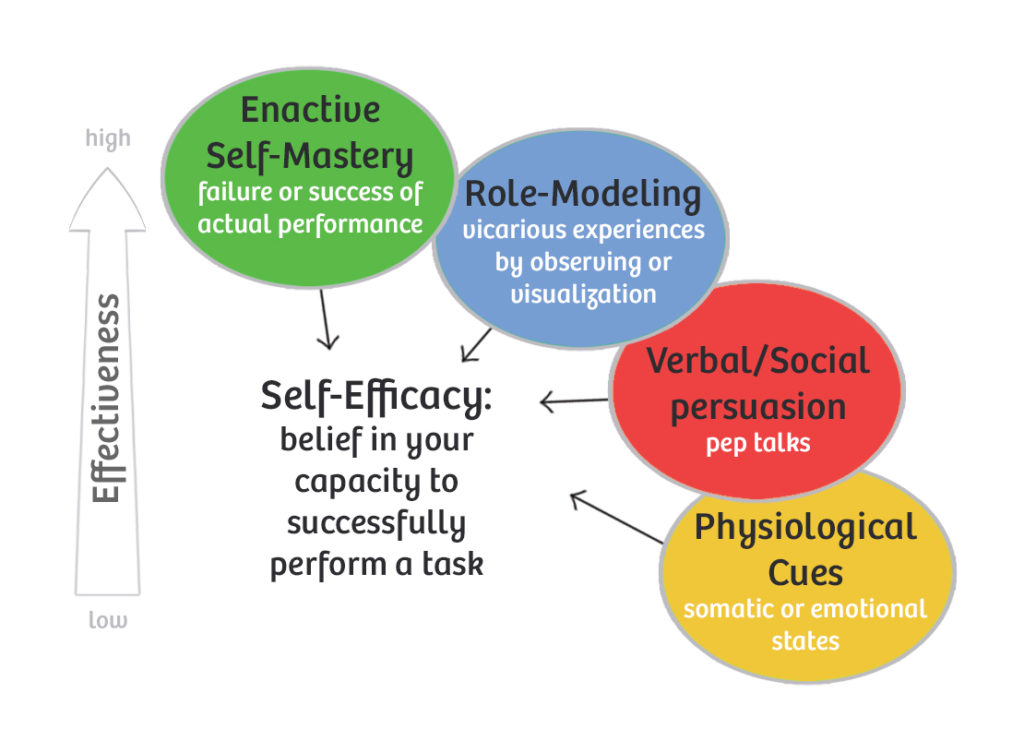What It Is:
Albert Bandura’s theory of self-efficacy is based on the idea that an individual’s belief in their own ability to perform a task influences their behavior, motivation, and overall success. According to Bandura, there are four primary sources of self-efficacy:
- Mastery Experiences:
- Explanation: Success in past experiences builds confidence. If someone has successfully completed a similar task before, they are likely to believe in their ability to do it again.
- Coaching Approach: Encourage team members to reflect on their past successes. Recognize and celebrate small victories to boost confidence. Provide opportunities for team members to master new skills incrementally.
- Vicarious Learning (Modeling):
- Explanation: Observing others successfully perform a task can increase self-efficacy. If team members see someone similar to themselves succeed, they are more likely to believe in their own capabilities.
- Coaching Approach: Facilitate knowledge sharing within the team. Encourage team members to observe and learn from each other. Share stories of team members who have overcome challenges successfully.
- Social Persuasion:
- Explanation: Positive encouragement, feedback, and support from others can influence self-efficacy. When individuals receive positive reinforcement or support from colleagues, leaders, or mentors, it enhances their belief in their abilities.
- Coaching Approach: Provide constructive and positive feedback. Recognize and appreciate individual and team efforts. Encourage a supportive team culture where team members motivate and uplift each other.
- Physiological and Emotional States:
- Explanation: One’s physical and emotional state can affect self-efficacy. Feeling anxious, stressed, or fatigued may lower confidence, while a positive emotional state can enhance belief in one’s capabilities.
- Coaching Approach: Be mindful of the team’s emotional well-being. Foster a positive work environment. Help team members manage stress and anxiety through techniques like mindfulness or stress-relief activities.
How to Use It:
Applying Sources of Self-Efficacy in Agile Coaching:
- Individual Goal Setting:
- Work with team members to set achievable and challenging goals, providing a pathway for mastery experiences.
- Encouraging Collaboration:
- Foster an environment where team members collaborate, share knowledge, and learn from each other (vicarious learning).
- Feedback and Recognition:
- Provide regular and constructive feedback, acknowledging achievements and efforts (social persuasion).
- Mindfulness and Well-being:
- Support the team in managing stress, promoting a positive emotional state for improved self-efficacy (physiological and emotional states).
See Also:
References:
Resources on Self-Efficacy and Albert Bandura:
- Books by Albert Bandura:
- “Self-Efficacy: The Exercise of Control” by Albert Bandura.
- Academic Journals and Articles:
- Explore academic journals and articles on psychology and self-efficacy for in-depth understanding.
- Educational Institutions and Psychology Departments:
- Check resources provided by educational institutions, especially psychology departments, for academic insights into self-efficacy.
- Online Psychology Databases:
- Utilize online psychology databases to access research papers, articles, and studies related to self-efficacy.
- Professional Development and Coaching Organizations:
- Organizations focusing on professional development and coaching often offer resources and workshops on psychological theories, including self-efficacy.
Remember to stay updated with the latest research, as the field of psychology and coaching continually evolves.
Visit the Agile Coach’s Toolkit for more definitions, models, theorems and stuff.

